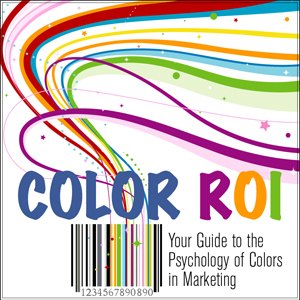The Consequences of Colors
Your ultimate guide to the psychology of colors in marketing
The Basics
80: percentage of what we assimilate through the senses is visual
92.6%: of consumers said that they put the most importance on visual factors when purchasing products.
5.6% said that the feel via sense of touch was the most important.
Hearing and touch each got 0.9%
Color and Marketing
For the first 100 years of modern branding, you could not trademark a color. But all that changed – thanks to insulation.
1987: Owens-Corning made legal history when it became the first company to trademark a single color: pink. They proved to the courts that their insulation was clearly identified as pink, they had spent over $50 million dollars marketing it.
When asked about the importance of color when shopping:
• More than 50%: of buyers say color is an important factor
• Ads in color are read up to 42% more often than the same ads in black and white
• Color increases brand recognition by 80%
TRUTH: Emotions evoked by a color are based more on personal experiences than on what we’re told they’re meant to represent.
The color red might remind one person of Christmas (warm, positive), while it makes another person think of the fire trucks on the day their house burned down (negative).
Tips on using color for kids
• Make sure you have the right target market.
• Young children materials contain large amounts of bright primary colors. These colors will attract the child, yet the parents or grandparents open the wallet.
• For children use the primary colors
• For the marketing material being read by the grand/parents, reds, blues, pinks and yellows indicate trust, reliability, security, and playful.
Common Color Associations used in business, sales and marketing campaigns
Red – Energy, war, danger, strength, rage, vigor, power, determination, passion, desire, and love.
Orange – Excitement, fascination, happiness, creativity, summer, success, encouragement, and stimulation
Yellow – Joy, sickness, spontaneity, happiness, intellect, freshness, joy, instability, and energy
Green – Growth, harmony, healing, safety, nature, greed, jealousy, cowardice, hope, inexperience, peace, protection.
Blue – Stability, depression, Nature (The sky, the ocean, water), tranquility, softness, depth, wisdom, intelligence.
Purple – Royalty, luxury, extravagance, dignity, magic, wealth, mystery.
Pink – Love, romance, friendship, passiveness, nostalgia, sexuality.
White – Purity, faith, innocence, cleanliness, safety, medicine, beginnings, snow.
Grey – Dreariness, gloom, neutrality, decisions
Black – Solemnity, death, fear, evil, mystery, power, elegance, the unknown, elegance, grief, tragedy, prestige.
Brown – Harvest, wood, chocolate, dependability, simplicity, relaxation, the outdoors, filth, disease, disgust
Do the associations above correspond with the products and services of the companies below?
Logos By Color
Red – Kellogg’s, CNN, Lego, Target, Coca Cola, Nintendo, Exxon, Lays, Nabisco, Canon, KFC, Netflix
Orange – Firefox, Harley Davidson, Fanta, Nickelodeon, Home Depot, Fanta, Hooters
Yellow – Best Buy, The Yellow Pages, Sprint, IMDb, UPS, McDonalds, Subway, IKEA
Green – BP, Starbucks, Android, Animal Planet, H&R Block, John Deere
Blue – AT&T, IBM, HP, Lowes, Dell, Intel, Facebook, Walmart, GE, Twitter
Purple – Yahoo, T Mobile, Taco Bell, Cadbury, Aetna, FedEx, Welch’s
Pink – Playboy, Barbie, Hello Kitty, Dunkin Donuts
Black – The New York Times, Nike, NBC, Wikipedia, Cartoon Network, Puma, Adidas, Volcom
Brown – UPS
FACT: Why is Facebook blue? Because Mark Zuckerberg is red-green colorblind. Blue is the color Mark can see the best.
Color Harmonies Used in Marketing
Complementary – Colors that are opposite each other on the color wheel are considered complementary. The contrast between these colors is very attention catching.
Analogous – This is the use colors that are grouped together on the color wheel, generally a primary color and its various shades. Analogous color schemes are generally considered pleasing to the eye.
Triadic – The use of three colors evenly spaced on the color wheel. Triadic color schemes are quite vibrant.
How Companies Use color, on their logo, on their website
WalMart
• Has branded itself over the years as the leader in low-cost retail goods.
• It uses the color blue in just about all of its branding efforts.
• In recent years, WalMart has been trying to upgrade its image in the eyes of customers, but the familiar blue color has not gone away.
• Like most retailers’ websites, WalMart’s is primarily white, but there is plenty of blue to give it the familiar feel. Navigation and headlines are blue throughout most of the website — the same blue color and same WalMart logo found at WalMart’s retail locations.
McDonald’s
• Well recognized for its golden arches and prominent red.
• But the US home page for McDonald’s does little to build on this strong brand that has been built over a long period of time. The golden arches logo is there, but black is used much more heavily than the gold and red color scheme.
Coca-Cola
• For decades, the Coca-Cola brand has been built with a very familiar red and white color scheme.
• Everything from product packaging to displays in retail stores to advertisements has predominantly used the same color scheme, and as a result the Coke brand is one of the strongest in the world.
• The Coca-Cola website does use the red and white color scheme, but there is much less red than you would expect.
Ford
• US automaker Ford has built its own brand with steady and consistent use of blue. The Ford website is an extension of this branding effort as blue is used as the background color.
• Although a brand’s colors don’t necessarily have to be used as the background color of the website (most companies still use a white background), Ford manages to push its brand with heavy use of blue on the website.
• Even design elements such as the search button and the secondary navigation towards the bottom of the screen use shades of blue.
Sources:
http://www.joehallock.com/edu/COM498/preferences.html
http://www.bourncreative.com/meaning-of-the-color-brown/
http://www.tigercolor.com/color-lab/color-theory/color-harmonies.htm
http://precisionintermedia.com/color
http://colorcom.com/research/why-color-matters
http://colormatters.com/color-and-marketing/color-and-branding
http://www.smashingmagazine.com/2009/01/28/colors-in-corporate-branding-and-design/







